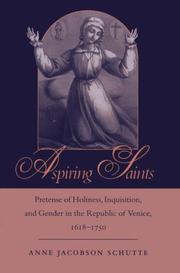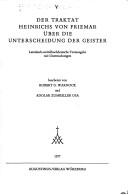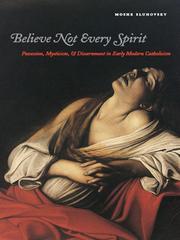| Listing 1 - 10 of 14 | << page >> |
Sort by
|
Book
ISBN: 0912422424 0912422432 9780912422435 9780912422428 Year: 1982 Volume: 5 Publisher: Anand Gujarat Sahitya Prakash
Abstract | Keywords | Export | Availability | Bookmark
 Loading...
Loading...Choose an application
- Reference Manager
- EndNote
- RefWorks (Direct export to RefWorks)
#GBIB: jesuitica --- Christian spirituality --- Ignatius of Loyola --- Discernment of spirits --- Spirits, Discernment of --- History of doctrines --- Ignatius, --- Demonology --- Experience (Religion) --- Psychology, Religious --- Discernment of spirits - History of doctrines - 16th century. --- Ignatius, - of Loyola, Saint, - 1491-1556. - Exercitia spiritualia.

ISBN: 0801876869 9780801876868 0801865484 9780801865480 Year: 2001 Publisher: Baltimore, Md. : Johns Hopkins University Press,
Abstract | Keywords | Export | Availability | Bookmark
 Loading...
Loading...Choose an application
- Reference Manager
- EndNote
- RefWorks (Direct export to RefWorks)
Inquisition --- Visionaries --- Holiness --- Discernment of spirits --- Women in the Catholic Church --- Spirits, Discernment of --- Demonology --- Experience (Religion) --- Psychology, Religious --- Holy, The --- Perfection --- Righteousness --- Sanctification --- Persons --- Apparitions --- Visions --- Holy Office --- Autos-da-fé --- History --- Catholic Church --- History of doctrines --- Religious aspects

ISBN: 220405528X 9782204055284 Year: 1997 Volume: 204 Publisher: Paris Cerf
Abstract | Keywords | Export | Availability | Bookmark
 Loading...
Loading...Choose an application
- Reference Manager
- EndNote
- RefWorks (Direct export to RefWorks)
Discernment of spirits --- God (Christianity) --- History of doctrines --- Knowableness. --- #GBIB: jesuitica --- 2 IGNATIUS DE LOYOLA --- -God --- -Metaphysics --- Misotheism --- Monotheism --- Religion --- Theism --- Spirits, Discernment of --- Demonology --- Experience (Religion) --- Psychology, Religious --- Godsdienst. Theologie--IGNATIUS DE LOYOLA --- -Knowableness --- Ignatius of Loyola, Saint --- -Godsdienst. Theologie--IGNATIUS DE LOYOLA --- 2 IGNATIUS DE LOYOLA Godsdienst. Theologie--IGNATIUS DE LOYOLA --- -Spirits, Discernment of --- Knowableness of God --- Knowledge of God (Knowableness of God) --- Knowableness --- Knowledge (Knowableness) --- Ignatius, --- Discernment of spirits - History of doctrines - 16th century. --- God (Christianity) - Knowableness.
Book
ISBN: 9782910487478 Year: 2011 Volume: 8 Publisher: Paris Nolin
Abstract | Keywords | Export | Availability | Bookmark
 Loading...
Loading...Choose an application
- Reference Manager
- EndNote
- RefWorks (Direct export to RefWorks)
Christian spirituality --- anno 1600-1699 --- 248.131.5 --- #GBIB: jesuitica --- Regels over de onderscheiding van de geesten --- Conferences - Meetings --- 248.131.5 Regels over de onderscheiding van de geesten --- Discernment of spirits --- Spirits, Discernment of --- Demonology --- Experience (Religion) --- Psychology, Religious --- History of doctrines

ISBN: 3761301111 9783761301111 Year: 1977 Volume: 32 Publisher: Würzburg Augustinus-Verl.
Abstract | Keywords | Export | Availability | Bookmark
 Loading...
Loading...Choose an application
- Reference Manager
- EndNote
- RefWorks (Direct export to RefWorks)
Discernment of spirits --- Manuscripts, German --- Manuscripts, Latin (Medieval and modern) --- #GOSA:XX.III.D.Hen-F.O --- Medieval and modern Latin manuscripts --- Manuscripts, Medieval --- German manuscripts --- Spirits, Discernment of --- Demonology --- Experience (Religion) --- Psychology, Religious --- Discernment of spirits. --- Manuscripts, German. --- Manuscripts, Latin (Medieval and modern).

ISBN: 1501702181 0801473349 080144084X 9780801473340 9780801440847 1501702173 9781501702181 Year: 2006 Publisher: Ithaca, New York ; London, [England] : Cornell University Press,
Abstract | Keywords | Export | Availability | Bookmark
 Loading...
Loading...Choose an application
- Reference Manager
- EndNote
- RefWorks (Direct export to RefWorks)
Trance states, prophesying, convulsions, fasting, and other physical manifestations were often regarded as signs that a person was seized by spirits. In a book that sets out the prehistory of the early modern European witch craze, Nancy Caciola shows how medieval people decided whom to venerate as a saint infused with the spirit of God and whom to avoid as a demoniac possessed of an unclean spirit. This process of discrimination, known as the discernment of spirits, was central to the religious culture of Western Europe between 1200 and 1500. Since the outward manifestations of benign and malign possession were indistinguishable, a highly ambiguous set of bodily features and behaviors were carefully scrutinized by observers. Attempts to make decisions about individuals who exhibited supernatural powers were complicated by the fact that the most intense exemplars of lay spirituality were women, and the "fragile sex" was deemed especially vulnerable to the snares of the devil. Assessments of women's spirit possessions often oscillated between divine and demonic interpretations. Ultimately, although a few late medieval women visionaries achieved the prestige of canonization, many more were accused of possession by demons. Caciola analyzes a broad array of sources from saints' lives to medical treatises, exorcists' manuals to miracle accounts, to find that observers came to rely on the discernment of bodies rather than seeking to distinguish between divine and demonic possession in purely spiritual terms.
Christianity --- Religion --- Philosophy & Religion --- Discernment of spirits --- Women in Christianity --- History of doctrines --- History --- Spirits, Discernment of --- Demonology --- Experience (Religion) --- Psychology, Religious --- Christian dogmatics --- anno 500-1499 --- Middle Ages, 600-1500 --- Middle Ages, 500-1500 --- Femmes dans le christianisme --- Discernement des esprits --- Histoire --- Histoire des doctrines
Book
ISBN: 2858470294 Year: 1982 Publisher: Paris Pneumathèque
Abstract | Keywords | Export | Availability | Bookmark
 Loading...
Loading...Choose an application
- Reference Manager
- EndNote
- RefWorks (Direct export to RefWorks)
Clairvoyance --- Discernment of spirits --- Gifts, Spiritual --- Spiritual healing --- Divine healing --- Faith-cure --- Faith healing --- Spiritual therapies --- Healing --- Miracles --- Charismata --- Gifts of grace --- Gifts of the Holy Spirit --- Grace, Gifts of --- Spiritual gifts --- Grace (Theology) --- Pentecostalism --- Spirits, Discernment of --- Demonology --- Experience (Religion) --- Psychology, Religious --- Extrasensory perception --- Religious aspects --- Christian spirituality

ISBN: 9780226762821 0226762823 Year: 2007 Publisher: Chicago ; London University of Chicago Press
Abstract | Keywords | Export | Availability | Bookmark
 Loading...
Loading...Choose an application
- Reference Manager
- EndNote
- RefWorks (Direct export to RefWorks)
From 1400 through 1700, the number of reports of demonic possessions among European women was extraordinarily high. During the same period, a new type of mysticism-popular with women-emerged that greatly affected the risk of possession and, as a result, the practice of exorcism. Many feared that in moments of rapture, women, who had surrendered their souls to divine love, were not experiencing the work of angels, but rather the ravages of demons in disguise. So how then, asks Moshe Sluhovsky, were practitioners of exorcism to distinguish demonic from divine possessions?
Christian dogmatics --- Demonology --- Discernment of spirits --- Demoniac possession --- Spirit possession --- Exorcism --- Mysticism --- 248.23 --- Dark night of the soul --- Mystical theology --- Theology, Mystical --- Spiritual life --- Negative theology --- Evil spirits, Expulsion of --- Expulsion of evil spirits --- Rites and ceremonies --- Possession, Spirit --- Experience (Religion) --- Demonic possession --- Possession, Demoniac --- Spirits, Discernment of --- Psychology, Religious --- Demonology, Christian --- Demons --- Evil spirits --- Spirits --- Spiritual warfare --- Ongewone feiten met natuurlijke verklaring. Illusies --- Demoniac possession. --- Demonology. --- Discernment of spirits. --- Exorcism. --- Mysticism. --- Spirit possession. --- Religion --- Philosophy & Religion --- Christianity --- 248.23 Ongewone feiten met natuurlijke verklaring. Illusies

ISBN: 3161483871 9783161483875 Year: 2004 Volume: 185 Publisher: Tübingen Mohr Siebeck
Abstract | Keywords | Export | Availability | Bookmark
 Loading...
Loading...Choose an application
- Reference Manager
- EndNote
- RefWorks (Direct export to RefWorks)
Discernment of spirits --- Bible --- Criticism, interpretation, etc --- 225*2 --- 226.1 --- Jezus Christus in het Nieuwe Testament: christologie --- Evangelies: synoptici; synoptisch probleem; Q; Quelle --- 226.1 Evangelies: synoptici; synoptisch probleem; Q; Quelle --- 225*2 Jezus Christus in het Nieuwe Testament: christologie --- Spirits, Discernment of --- Demonology --- Experience (Religion) --- Psychology, Religious --- Bible. --- Evangelie (Book of the New Testament) --- Fukuinsho (Books of the New Testament) --- Gospels (Books of the New Testament) --- Gospels, Synoptic (Books of the New Testament) --- Synoptic Gospels (Books of the New Testament) --- Criticism, interpretation, etc.

ISBN: 1281966525 9786611966522 0226762955 9780226762951 9781281966520 9780226762821 0226762823 6611966528 Year: 2007 Publisher: Chicago University of Chicago Press
Abstract | Keywords | Export | Availability | Bookmark
 Loading...
Loading...Choose an application
- Reference Manager
- EndNote
- RefWorks (Direct export to RefWorks)
From 1400 through 1700, the number of reports of demonic possessions among European women was extraordinarily high. During the same period, a new type of mysticism-popular with women-emerged that greatly affected the risk of possession and, as a result, the practice of exorcism. Many feared that in moments of rapture, women, who had surrendered their souls to divine love, were not experiencing the work of angels, but rather the ravages of demons in disguise. So how then, asks Moshe Sluhovsky, were practitioners of exorcism to distinguish demonic from divine possessions?
Demonology. --- Discernment of spirits. --- Demoniac possession. --- Spirit possession. --- Exorcism. --- Mysticism. --- Spirits, Discernment of --- Demonology --- Experience (Religion) --- Psychology, Religious --- Demonology, Christian --- Demons --- Evil spirits --- Spirits --- Spiritual warfare --- Dark night of the soul --- Mystical theology --- Theology, Mystical --- Spiritual life --- Negative theology --- Evil spirits, Expulsion of --- Expulsion of evil spirits --- Rites and ceremonies --- Possession, Spirit --- Demonic possession --- Possession, Demoniac --- Spirit possession --- possession, possessed, mystic, mysticism, discernment, discerning, catholicism, catholics, religion, religious, christianity, christians, faith, history, historical, demonic possessions, european, women, gender, rapture, divine love, angels and demons, spirituality, spiritual, testimonies, theology, theological, good, evil, body, soul, interiority, exteriority, demonology, exorcism, contemplation, sexuality, sexual misconduct, ritual, convent.
| Listing 1 - 10 of 14 | << page >> |
Sort by
|

 Search
Search Feedback
Feedback About
About Help
Help News
News